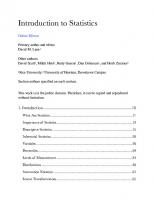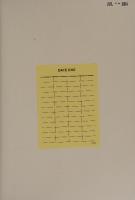Introduction to Statistics in Metrology 303053328X, 9783030533281
This book provides an overview of the application of statistical methods to problems in metrology, with emphasis on mode
407 71 12MB
English Pages 351 [357] Year 2021
Table of contents :
Preface
Contents
About the Authors
Chapter 1: Introduction
1.1 Measurement Uncertainty: Why Do We Care?
1.2 The History of Measurement
1.3 Measurement Science and Technological Development
1.4 Allegations of Deflated Footballs (``Deflategate´´)
1.5 Fatality Rates During a Pandemic
1.6 Summary
1.7 Related Reading
References
Chapter 2: Basic Measurement Concepts
2.1 Introduction
2.2 Measurement Terminology
2.2.1 General Measurement Terminology
2.2.1.1 Measurand
2.2.1.2 True Value (True Value of a Quantity)
2.2.1.3 Measurement Accuracy
2.2.1.4 Measurement Precision
2.2.1.5 Resolution
2.2.1.6 Measurement Repeatability
2.2.1.7 Measurement Reproducibility
2.2.1.8 Independence of Measurements
2.2.2 Error Approach Terminology
2.2.2.1 Measurement Error
2.2.2.2 Systematic Measurement Error
2.2.2.3 Random Measurement Error
2.2.3 Uncertainty Approach Terminology
2.2.3.1 Measurement Uncertainty
2.2.3.2 Level of Confidence (Coverage Probability)
2.2.3.3 Coverage Interval
2.2.3.4 Measurement Model
2.2.4 Terminology of Calibration
2.2.4.1 Measuring and Test Equipment (M&TE)
2.2.4.2 Metrological Traceability
2.2.4.3 Calibration
2.2.4.4 Tolerance Test
2.2.4.5 Certification Uncertainty
2.3 Types of Measurements
2.3.1 Physical Measurements
2.3.2 Electrical Measurements
2.3.3 Other Types of Measurements
2.4 Sources of Uncertainty
2.4.1 Evaluating Sources of Uncertainty
2.5 Summary
2.6 Related Reading
2.7 Exercises
References
Chapter 3: The International System of Units, Traceability, and Calibration
3.1 History of the SI and Base Units
3.1.1 SI Constants
3.1.2 Time: Second (s)
3.1.3 Length: Meter (m)
3.1.4 Mass: Kilogram (kg)
3.1.5 Electric Current: Ampere (A)
3.1.6 Temperature: Kelvin (K)
3.1.7 Quantity of Substance: Mole (mol)
3.1.8 Luminous Intensity: Candela (cd)
3.2 Derived Units
3.3 Unit Realizations
3.3.1 Gauge Block Interferometer
3.3.2 Josephson Volt
3.4 Advancements in Unit Definitions
3.4.1 Kibble (Watt) Balance
3.4.2 Intrinsic Pressure Standard
3.5 Metrological Traceability
3.6 Measurement Standards
3.6.1 Certified Reference Materials
3.6.2 Check Standards
3.7 Calibration
3.7.1 The Calibration Cycle
3.7.2 Legal Aspects of Calibration
3.7.3 Technical Aspects of Calibration
3.7.4 Calibration Policies and Requirements
3.7.4.1 ISO 17025
3.7.4.2 ANSI Z540.1 and ANSI/NCSL Z540.3:2006
3.8 Summary
3.9 Related Reading
3.10 Exercises
References
Chapter 4: Introduction to Statistics and Probability
4.1 Introduction
4.2 Types of Data
4.3 Exploratory Data Analysis
4.3.1 Calculating Summary Statistics
4.3.1.1 Summary Statistics for Continuous Data
4.3.1.2 Summary Statistics for Discrete Data
4.3.2 Graphical Displays of Data
4.3.2.1 Graphical Displays for Continuous Data
4.3.2.2 Graphical Displays for Discrete Data
4.4 Probability Distributions
4.4.1 Identification of Probability Distributions
4.4.1.1 Continuous Distributions
4.4.1.2 Discrete Distributions
4.4.2 Estimating Distribution Parameters
4.4.3 Assessing Distributional Fit
4.5 Related Reading
4.6 Exercises
References
Chapter 5: Measurement Uncertainty in Decision Making
5.1 Introduction
5.2 Measurement Uncertainty and Risk
5.2.1 Measurement Uncertainty and Risk in Manufacturing
5.2.1.1 Test Uncertainty Ratio
5.2.1.2 Measurement Decisions
5.2.1.3 False Accept and False Reject Risks
5.2.1.4 Guardbanding
5.2.1.5 Risk with Biased Measurements
5.2.2 Measurement Uncertainty and Risk in Calibration
5.2.2.1 Decision Rules in Calibration
5.3 Summary
5.4 Related Reading
5.5 Exercises
References
Chapter 6: The Measurement Model and Uncertainty
6.1 Introduction
6.2 Uncertainty Analysis Framework
6.2.1 Standard Uncertainty
6.2.2 Type A Uncertainty Evaluation
6.2.3 Type B Uncertainty Evaluation
6.2.4 Combined Standard Uncertainty
6.2.5 Confidence Level and Expanded Uncertainty
6.3 Direct Measurements and the Basic Measurement Model
6.3.1 Case Study: Voltage Measurement
6.3.2 Discussion
6.4 Indirect Measurements and the Indirect Measurement Model
6.4.1 Case Study: Neutron Yield Measurement
6.4.2 Discussion
6.5 Related Reading
6.6 Exercises
References
Chapter 7: Analytical Methods for the Propagation of Uncertainties
7.1 Introduction
7.2 Mathematical Basis
7.3 The Simple Case: First-Order Terms with Uncorrelated Inputs
7.3.1 Measurement Examples
7.4 First-Order Terms with Correlated Inputs
7.4.1 Covariance, Correlation, and Effect on Uncertainty
7.4.2 Measurement Examples
7.5 Higher-Order Terms with Uncorrelated Inputs
7.5.1 Measurement Examples
7.6 Multiple Output Quantities
7.7 Limitations of the Analytical Approach
7.8 Related Reading
7.9 Exercises
References
Chapter 8: Monte Carlo Methods for the Propagation of Uncertainties
8.1 Introduction to Monte Carlo Methods
8.1.1 Random Sampling Techniques and Random Number Generation
8.1.1.1 Sampling from Normal and Non-Normal Distributions
8.1.1.2 Generating Correlated Random Samples (Normal Distribution)
8.1.2 Generation of Probability Density Functions Using Random Data
8.1.3 Computational Approaches
8.1.3.1 Linear Congruential Generator
8.1.3.2 Better PRNG Algorithms
8.2 Standard Monte Carlo for Uncertainty Propagation
8.2.1 Monte Carlo Techniques
8.2.1.1 Case Study: Calculating Density
8.2.1.2 Sensitivity Coefficients
8.2.1.3 Convergence Plots and Adaptive Sampling
8.3 Comparison to the GUM
8.3.1 Quantitative GUM Validity Test
8.4 Monte Carlo Case Studies
8.4.1 Case Study: Neutron Yield Measurement
8.4.2 Case Study: RC Circuit
8.5 Summary
8.6 Related Reading
8.7 Exercises
References
Chapter 9: Design of Experiments in Metrology
9.1 Introduction
9.2 Factorial Experiments in Metrology
9.2.1 Defining the Measurand and Objective of the Experiment
9.2.2 Selecting Factors to Incorporate in the Experiment
9.2.3 Selecting Factor Levels and Design Pattern
9.2.4 Analysis of CMM Errors via Design of Experiments (24 Full Factorial)
9.2.5 Finite Element Method (FEM) Uncertainty Analysis via Design of Experiments (27-3 Fractional Factorial)
9.2.6 Summary of Factorial DOEx Method
9.3 ANOVA Models in Metrology
9.3.1 Random Effects Models
9.3.2 Mixed Effects Models
9.3.3 Underlying ANOVA Assumptions
9.3.4 Gauge R&R Study (Random Effects Model)
9.3.5 Voltage Standard Uncertainty Analysis (Mixed Effects Model)
9.3.6 Summary of ANOVA Method
9.4 Related Reading
9.5 Exercises
References
Chapter 10: Determining Uncertainties in Fitted Curves
10.1 The Purpose of Fitting Curves to Experimental Data
10.1.1 Resistance vs. Temperature Data
10.1.2 Considerations When Fitting Models to Data
10.2 Methods for Fitting Curves to Experimental Data
10.2.1 Linear Least Squares
10.2.2 Uncertainty in Fitting Parameters
10.2.3 Weighted Least Squares: Non-constant u(y)
10.2.4 Weighted Least Squares: Uncertainty in Both x and y
10.3 Uncertainty of a Regression Line
10.3.1 Uncertainty of Fitting Parameters
10.3.2 Confidence Bands
10.3.3 Prediction Bands
10.4 How Good Is the Model?
10.4.1 Residual Analysis
10.4.2 Slope Test
10.4.3 Quantitative Residual Analysis
10.5 Uncertainty in Nonlinear Regression
10.5.1 Nonlinear Least Squares
10.5.2 Orthogonal Distance Regression
10.5.3 Confidence and Prediction Bands in Nonlinear Regression
10.6 Using Monte Carlo for Evaluating Uncertainties in Curve Fitting
10.6.1 Monte Carlo Approach
10.6.2 Markov-Chain Monte Carlo Approach
10.7 Case Study: Contact Resistance
10.8 Drift and Predicting Future Values
10.8.1 Uncertainty During Use
10.8.2 Validating Drift Uncertainty
10.8.2.1 Type B Uncertainty
10.8.2.2 Type A Measurement Uncertainty
10.8.2.3 Drift Uncertainty
10.8.2.4 Expanded Uncertainty
10.9 Calibration Interval Analysis
10.10 Summary
10.11 Related Reading
10.12 Exercises
References
Chapter 11: Special Topics in Metrology
11.1 Introduction
11.2 Statistical Process Control (SPC)
11.2.1 Case Study: Battery Tester Uncertainty and Monitoring Via SPC
11.2.2 Discussion
11.3 Binary Measurement Systems (BMS)
11.3.1 BMS Overview
11.3.2 BMS Case Study Introduced
11.3.3 Evaluation of a BMS
11.3.3.1 Within-Operator Agreement
11.3.3.2 Between-Operator Agreement
11.3.3.3 Assessing BMS Correctness
11.3.4 Sample Sizes for a BMS Study
11.4 Measurement System Analysis with Destructive Testing
11.5 Sample Size and Allocation of Samples in Metrology Experiments
11.6 Summary of Sample Size Recommendations
11.7 Bayesian Analysis in Metrology
11.8 Related Reading
11.9 Exercises
References
Appendix A: Acronyms and Abbreviations
Appendix B: Guidelines for Valid Measurements
Related Reading: Electrical Measurements
Related Reading: Time and Frequency Measurements
Related Reading: Physical Measurements
Related Reading: Temperature Measurement
Related Reading: Radiation
Related Reading: General Measurement and Instrumentation Techniques
Appendix C: Uncertainty Budget Case Study: CMM Length Measurements
Coordinate Measuring Machine (CMM) Measurements
Product Acceptance Uncertainty: Dimensional Part Inspection with a CMM
Radius of Curvature of a Spherical Mirror
The Measurement Model
Measurement Considerations
Surface Form of the Mirror
CMM Probing Force
ROC Measurement
Uncertainty Analysis
CMM Measurement Process Uncertainty
CMM Positioning Error (Standards)
Fit Uncertainty
Combined Standard Uncertainty: u(R)
Final Results
Related Reading
Appendix D: Uncertainty Quick Reference
GUM Method for Measurement Uncertainty
Percentage Points of the t Distribution
Guardbanding
Symmetric Specification Limits
Asymmetric Specification Limits
One-Sided Specification Limits
Metrology Reference Table
Appendix E: R for Metrology
Introduction
Installation of R
R Packages
R for Metrology
Summary
References
Index
Preface
Contents
About the Authors
Chapter 1: Introduction
1.1 Measurement Uncertainty: Why Do We Care?
1.2 The History of Measurement
1.3 Measurement Science and Technological Development
1.4 Allegations of Deflated Footballs (``Deflategate´´)
1.5 Fatality Rates During a Pandemic
1.6 Summary
1.7 Related Reading
References
Chapter 2: Basic Measurement Concepts
2.1 Introduction
2.2 Measurement Terminology
2.2.1 General Measurement Terminology
2.2.1.1 Measurand
2.2.1.2 True Value (True Value of a Quantity)
2.2.1.3 Measurement Accuracy
2.2.1.4 Measurement Precision
2.2.1.5 Resolution
2.2.1.6 Measurement Repeatability
2.2.1.7 Measurement Reproducibility
2.2.1.8 Independence of Measurements
2.2.2 Error Approach Terminology
2.2.2.1 Measurement Error
2.2.2.2 Systematic Measurement Error
2.2.2.3 Random Measurement Error
2.2.3 Uncertainty Approach Terminology
2.2.3.1 Measurement Uncertainty
2.2.3.2 Level of Confidence (Coverage Probability)
2.2.3.3 Coverage Interval
2.2.3.4 Measurement Model
2.2.4 Terminology of Calibration
2.2.4.1 Measuring and Test Equipment (M&TE)
2.2.4.2 Metrological Traceability
2.2.4.3 Calibration
2.2.4.4 Tolerance Test
2.2.4.5 Certification Uncertainty
2.3 Types of Measurements
2.3.1 Physical Measurements
2.3.2 Electrical Measurements
2.3.3 Other Types of Measurements
2.4 Sources of Uncertainty
2.4.1 Evaluating Sources of Uncertainty
2.5 Summary
2.6 Related Reading
2.7 Exercises
References
Chapter 3: The International System of Units, Traceability, and Calibration
3.1 History of the SI and Base Units
3.1.1 SI Constants
3.1.2 Time: Second (s)
3.1.3 Length: Meter (m)
3.1.4 Mass: Kilogram (kg)
3.1.5 Electric Current: Ampere (A)
3.1.6 Temperature: Kelvin (K)
3.1.7 Quantity of Substance: Mole (mol)
3.1.8 Luminous Intensity: Candela (cd)
3.2 Derived Units
3.3 Unit Realizations
3.3.1 Gauge Block Interferometer
3.3.2 Josephson Volt
3.4 Advancements in Unit Definitions
3.4.1 Kibble (Watt) Balance
3.4.2 Intrinsic Pressure Standard
3.5 Metrological Traceability
3.6 Measurement Standards
3.6.1 Certified Reference Materials
3.6.2 Check Standards
3.7 Calibration
3.7.1 The Calibration Cycle
3.7.2 Legal Aspects of Calibration
3.7.3 Technical Aspects of Calibration
3.7.4 Calibration Policies and Requirements
3.7.4.1 ISO 17025
3.7.4.2 ANSI Z540.1 and ANSI/NCSL Z540.3:2006
3.8 Summary
3.9 Related Reading
3.10 Exercises
References
Chapter 4: Introduction to Statistics and Probability
4.1 Introduction
4.2 Types of Data
4.3 Exploratory Data Analysis
4.3.1 Calculating Summary Statistics
4.3.1.1 Summary Statistics for Continuous Data
4.3.1.2 Summary Statistics for Discrete Data
4.3.2 Graphical Displays of Data
4.3.2.1 Graphical Displays for Continuous Data
4.3.2.2 Graphical Displays for Discrete Data
4.4 Probability Distributions
4.4.1 Identification of Probability Distributions
4.4.1.1 Continuous Distributions
4.4.1.2 Discrete Distributions
4.4.2 Estimating Distribution Parameters
4.4.3 Assessing Distributional Fit
4.5 Related Reading
4.6 Exercises
References
Chapter 5: Measurement Uncertainty in Decision Making
5.1 Introduction
5.2 Measurement Uncertainty and Risk
5.2.1 Measurement Uncertainty and Risk in Manufacturing
5.2.1.1 Test Uncertainty Ratio
5.2.1.2 Measurement Decisions
5.2.1.3 False Accept and False Reject Risks
5.2.1.4 Guardbanding
5.2.1.5 Risk with Biased Measurements
5.2.2 Measurement Uncertainty and Risk in Calibration
5.2.2.1 Decision Rules in Calibration
5.3 Summary
5.4 Related Reading
5.5 Exercises
References
Chapter 6: The Measurement Model and Uncertainty
6.1 Introduction
6.2 Uncertainty Analysis Framework
6.2.1 Standard Uncertainty
6.2.2 Type A Uncertainty Evaluation
6.2.3 Type B Uncertainty Evaluation
6.2.4 Combined Standard Uncertainty
6.2.5 Confidence Level and Expanded Uncertainty
6.3 Direct Measurements and the Basic Measurement Model
6.3.1 Case Study: Voltage Measurement
6.3.2 Discussion
6.4 Indirect Measurements and the Indirect Measurement Model
6.4.1 Case Study: Neutron Yield Measurement
6.4.2 Discussion
6.5 Related Reading
6.6 Exercises
References
Chapter 7: Analytical Methods for the Propagation of Uncertainties
7.1 Introduction
7.2 Mathematical Basis
7.3 The Simple Case: First-Order Terms with Uncorrelated Inputs
7.3.1 Measurement Examples
7.4 First-Order Terms with Correlated Inputs
7.4.1 Covariance, Correlation, and Effect on Uncertainty
7.4.2 Measurement Examples
7.5 Higher-Order Terms with Uncorrelated Inputs
7.5.1 Measurement Examples
7.6 Multiple Output Quantities
7.7 Limitations of the Analytical Approach
7.8 Related Reading
7.9 Exercises
References
Chapter 8: Monte Carlo Methods for the Propagation of Uncertainties
8.1 Introduction to Monte Carlo Methods
8.1.1 Random Sampling Techniques and Random Number Generation
8.1.1.1 Sampling from Normal and Non-Normal Distributions
8.1.1.2 Generating Correlated Random Samples (Normal Distribution)
8.1.2 Generation of Probability Density Functions Using Random Data
8.1.3 Computational Approaches
8.1.3.1 Linear Congruential Generator
8.1.3.2 Better PRNG Algorithms
8.2 Standard Monte Carlo for Uncertainty Propagation
8.2.1 Monte Carlo Techniques
8.2.1.1 Case Study: Calculating Density
8.2.1.2 Sensitivity Coefficients
8.2.1.3 Convergence Plots and Adaptive Sampling
8.3 Comparison to the GUM
8.3.1 Quantitative GUM Validity Test
8.4 Monte Carlo Case Studies
8.4.1 Case Study: Neutron Yield Measurement
8.4.2 Case Study: RC Circuit
8.5 Summary
8.6 Related Reading
8.7 Exercises
References
Chapter 9: Design of Experiments in Metrology
9.1 Introduction
9.2 Factorial Experiments in Metrology
9.2.1 Defining the Measurand and Objective of the Experiment
9.2.2 Selecting Factors to Incorporate in the Experiment
9.2.3 Selecting Factor Levels and Design Pattern
9.2.4 Analysis of CMM Errors via Design of Experiments (24 Full Factorial)
9.2.5 Finite Element Method (FEM) Uncertainty Analysis via Design of Experiments (27-3 Fractional Factorial)
9.2.6 Summary of Factorial DOEx Method
9.3 ANOVA Models in Metrology
9.3.1 Random Effects Models
9.3.2 Mixed Effects Models
9.3.3 Underlying ANOVA Assumptions
9.3.4 Gauge R&R Study (Random Effects Model)
9.3.5 Voltage Standard Uncertainty Analysis (Mixed Effects Model)
9.3.6 Summary of ANOVA Method
9.4 Related Reading
9.5 Exercises
References
Chapter 10: Determining Uncertainties in Fitted Curves
10.1 The Purpose of Fitting Curves to Experimental Data
10.1.1 Resistance vs. Temperature Data
10.1.2 Considerations When Fitting Models to Data
10.2 Methods for Fitting Curves to Experimental Data
10.2.1 Linear Least Squares
10.2.2 Uncertainty in Fitting Parameters
10.2.3 Weighted Least Squares: Non-constant u(y)
10.2.4 Weighted Least Squares: Uncertainty in Both x and y
10.3 Uncertainty of a Regression Line
10.3.1 Uncertainty of Fitting Parameters
10.3.2 Confidence Bands
10.3.3 Prediction Bands
10.4 How Good Is the Model?
10.4.1 Residual Analysis
10.4.2 Slope Test
10.4.3 Quantitative Residual Analysis
10.5 Uncertainty in Nonlinear Regression
10.5.1 Nonlinear Least Squares
10.5.2 Orthogonal Distance Regression
10.5.3 Confidence and Prediction Bands in Nonlinear Regression
10.6 Using Monte Carlo for Evaluating Uncertainties in Curve Fitting
10.6.1 Monte Carlo Approach
10.6.2 Markov-Chain Monte Carlo Approach
10.7 Case Study: Contact Resistance
10.8 Drift and Predicting Future Values
10.8.1 Uncertainty During Use
10.8.2 Validating Drift Uncertainty
10.8.2.1 Type B Uncertainty
10.8.2.2 Type A Measurement Uncertainty
10.8.2.3 Drift Uncertainty
10.8.2.4 Expanded Uncertainty
10.9 Calibration Interval Analysis
10.10 Summary
10.11 Related Reading
10.12 Exercises
References
Chapter 11: Special Topics in Metrology
11.1 Introduction
11.2 Statistical Process Control (SPC)
11.2.1 Case Study: Battery Tester Uncertainty and Monitoring Via SPC
11.2.2 Discussion
11.3 Binary Measurement Systems (BMS)
11.3.1 BMS Overview
11.3.2 BMS Case Study Introduced
11.3.3 Evaluation of a BMS
11.3.3.1 Within-Operator Agreement
11.3.3.2 Between-Operator Agreement
11.3.3.3 Assessing BMS Correctness
11.3.4 Sample Sizes for a BMS Study
11.4 Measurement System Analysis with Destructive Testing
11.5 Sample Size and Allocation of Samples in Metrology Experiments
11.6 Summary of Sample Size Recommendations
11.7 Bayesian Analysis in Metrology
11.8 Related Reading
11.9 Exercises
References
Appendix A: Acronyms and Abbreviations
Appendix B: Guidelines for Valid Measurements
Related Reading: Electrical Measurements
Related Reading: Time and Frequency Measurements
Related Reading: Physical Measurements
Related Reading: Temperature Measurement
Related Reading: Radiation
Related Reading: General Measurement and Instrumentation Techniques
Appendix C: Uncertainty Budget Case Study: CMM Length Measurements
Coordinate Measuring Machine (CMM) Measurements
Product Acceptance Uncertainty: Dimensional Part Inspection with a CMM
Radius of Curvature of a Spherical Mirror
The Measurement Model
Measurement Considerations
Surface Form of the Mirror
CMM Probing Force
ROC Measurement
Uncertainty Analysis
CMM Measurement Process Uncertainty
CMM Positioning Error (Standards)
Fit Uncertainty
Combined Standard Uncertainty: u(R)
Final Results
Related Reading
Appendix D: Uncertainty Quick Reference
GUM Method for Measurement Uncertainty
Percentage Points of the t Distribution
Guardbanding
Symmetric Specification Limits
Asymmetric Specification Limits
One-Sided Specification Limits
Metrology Reference Table
Appendix E: R for Metrology
Introduction
Installation of R
R Packages
R for Metrology
Summary
References
Index

- Author / Uploaded
- Stephen Crowder
- Collin Delker
- Eric Forrest
- Nevin Martin
![Introduction to Statistics in Metrology [1st ed.]
9783030533281, 9783030533298](https://ebin.pub/img/200x200/introduction-to-statistics-in-metrology-1st-ed-9783030533281-9783030533298.jpg)




![Introduction to Modern Statistics [2 ed.]](https://ebin.pub/img/200x200/introduction-to-modern-statistics-2nbsped.jpg)



